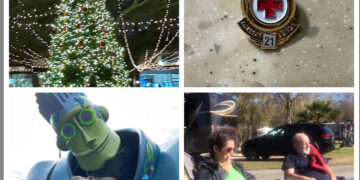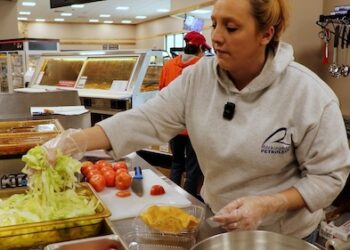I’ll be there if the crick don’t rise
As I write this month’s story, icy roads have closed schools for four days. Not being able to travel safely is a pain. But when I start to complain about today’s inconvenience, I remember how good the roads are now, compared to the Good Old Days.
Plentiful water attracted early settlers to Brocks Gap land. A spring made it easy to carry water to home and barn. Streams meant native trout and other fish for supper. Rivers powered water wheels for mills. All that water came with a price—when the streams overflowed their banks, no travel was possible.
Roads followed along stream banks because that was the easiest grade when road building was done with mules, hand tools, and neighbors. Our modern bridges and straight level roads make it hard to realize how frequently original roads crossed streams. For instance:
- Between Cootes Store and Chimney Rock there were five fords through the North Fork, and three of them were dangerous and ever shifting. In 1848, Elder John Kline and others met to propose a better route by building a bridge at Cootes Store and cutting down Gap rock to move the road to the Gap rock side of the river. Eventually their plan was implemented.
- In 1886, German River Road crossed the river several times in 100 yards above Shaver’s schoolhouse.
- In 1910, Runions Creek road forded the creek fourteen times between Route 259 and Bethel Mennonite church when services were held in Wade Runion’s old store building. Once on their way to church, Perry Shank’s family and buggy were nearly swept away by the creek.
- Before 1920, Bergton Road crossed the North Fork five times between Bergton store and my mother’s homeplace at 16948 Brocks Gap Road, Fulks Run.
Travelers in the Gap had to watch the river levels and adjust their plans accordingly. In December 1886, county school superintendent George Hulvey visited Brocks Gap schools on a four-day horseback trip. On the third day, rain and high water caused small attendance in Shaver and Caplinger Schools. With the river rapidly rising, he cut short his stay at Caplinger school to continue to Bergton. High water forced him to spend the night at Albrite’s. The next school he visited on Crab Run was closed, as “most of the pupils were cut off by the swollen streams, and they were just waiting for the waters to abate.”
Bad roads and dangerous fords harmed residents of Brocks Gap. In 1878, Strother Custer crossed the river near Riverside Church to visit a neighbor. A “heavy rainfall swelled the river considerably,” and he was drowned the next morning when attempting to re-cross to go home. His body was not found for two days.
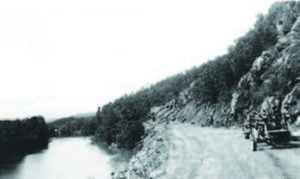
Driving a buggy through a swollen stream was fatal for midwife Elizabeth Estep Tusing who drowned February 28, 1902. She was returning home after delivering her granddaughter Sarah Alice Tusing, child of Amos Franklin Tusing and his wife Sarah Frances (Runion) Tusing.
Even when the streams weren’t over their banks, muddy roads made travel difficult. Two businesses near Fulks Run, E.D. Root’s lumber at Yankeetown and the Extract Factory, blamed their failure partially on the bad road. In the 1880s, newspaper columns of Fulks Run and Dovesville news frequently complained about the roads.
Even justice was postponed on account of the streams. Adam H. Fulk, Justice of the Peace at Fulks Run, had to schedule a court case based on how deep the river was in 1876.
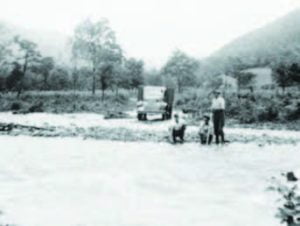
Roads and rivers restricted travel outside the Gap. Before automobiles, it could take two days to travel from Brocks Gap to Harrisonburg and two days back. Gap families often stayed overnight with friends at Broadway on their trip. However, not everyone was able to go to town. In 1891, 69-year-old Melvina Hulvey (1812-1909) of Little Dry River Road, went to Harrisonburg for the first time. She had been to Broadway only once before. Lewis Yankey (1903-2000) related that he was twelve years old the first time he went to Broadway from his Criders home.
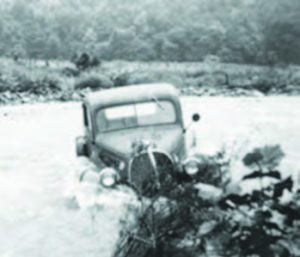
High water also affected dating. My uncle Granvil J. Turner (1921-2009) wrote of his courting days in the Genoa area. “I remember one Saturday I asked Grandma Clara to borrow their 1932 Studebaker—a very fine car. Violet [later Granvil’s wife] was over at her Grandmother’s. We went to the movies; a rain came up and the creek started to rise. As I was coming home the car stuck in the creek at ‘Jonny Arks’ now Ervine Tusing home (there was no bridge then). I waded out and went to Charlie Ritchie’s, knocked on his door at midnight. He came with his horse and pulled me out. The next day I took the car to Cootes Store Service, had the oil drained out of the engine and transmission before returning the car.”

since she was a teen.

























